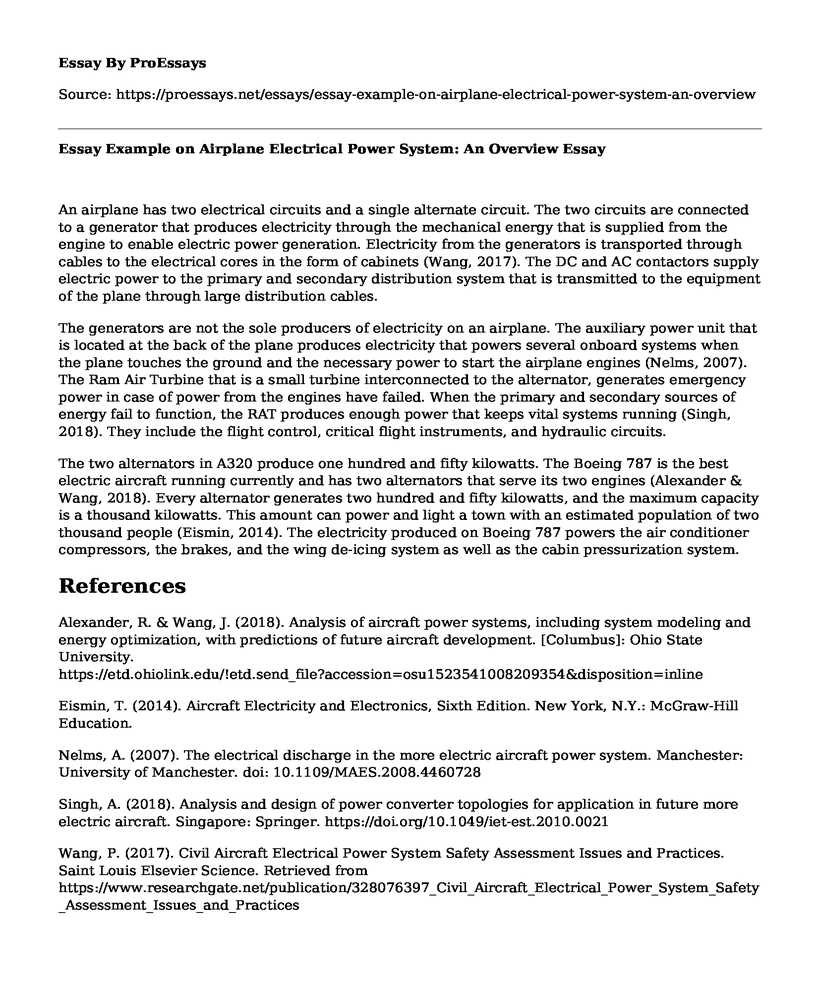An airplane has two electrical circuits and a single alternate circuit. The two circuits are connected to a generator that produces electricity through the mechanical energy that is supplied from the engine to enable electric power generation. Electricity from the generators is transported through cables to the electrical cores in the form of cabinets (Wang, 2017). The DC and AC contactors supply electric power to the primary and secondary distribution system that is transmitted to the equipment of the plane through large distribution cables.
The generators are not the sole producers of electricity on an airplane. The auxiliary power unit that is located at the back of the plane produces electricity that powers several onboard systems when the plane touches the ground and the necessary power to start the airplane engines (Nelms, 2007). The Ram Air Turbine that is a small turbine interconnected to the alternator, generates emergency power in case of power from the engines have failed. When the primary and secondary sources of energy fail to function, the RAT produces enough power that keeps vital systems running (Singh, 2018). They include the flight control, critical flight instruments, and hydraulic circuits.
The two alternators in A320 produce one hundred and fifty kilowatts. The Boeing 787 is the best electric aircraft running currently and has two alternators that serve its two engines (Alexander & Wang, 2018). Every alternator generates two hundred and fifty kilowatts, and the maximum capacity is a thousand kilowatts. This amount can power and light a town with an estimated population of two thousand people (Eismin, 2014). The electricity produced on Boeing 787 powers the air conditioner compressors, the brakes, and the wing de-icing system as well as the cabin pressurization system.
References
Alexander, R. & Wang, J. (2018). Analysis of aircraft power systems, including system modeling and energy optimization, with predictions of future aircraft development. [Columbus]: Ohio State University. https://etd.ohiolink.edu/!etd.send_file?accession=osu1523541008209354&disposition=inline
Eismin, T. (2014). Aircraft Electricity and Electronics, Sixth Edition. New York, N.Y.: McGraw-Hill Education.
Nelms, A. (2007). The electrical discharge in the more electric aircraft power system. Manchester: University of Manchester. doi: 10.1109/MAES.2008.4460728
Singh, A. (2018). Analysis and design of power converter topologies for application in future more electric aircraft. Singapore: Springer. https://doi.org/10.1049/iet-est.2010.0021
Wang, P. (2017). Civil Aircraft Electrical Power System Safety Assessment Issues and Practices. Saint Louis Elsevier Science. Retrieved from https://www.researchgate.net/publication/328076397_Civil_Aircraft_Electrical_Power_System_Safety_Assessment_Issues_and_Practices
Cite this page
Essay Example on Airplane Electrical Power System: An Overview. (2023, May 08). Retrieved from https://proessays.net/essays/essay-example-on-airplane-electrical-power-system-an-overview
If you are the original author of this essay and no longer wish to have it published on the ProEssays website, please click below to request its removal:
- Strategic Human Resource Management for Service Innovation at Singapore Airlines
- High-Speed Flight in Aviation Essay Example
- Paper Example on Aircraft Cockpit: Evolution Over Time
- Clean Energy: The Future of Pollution-Free Living - Essay Sample
- America's Pilot Shortage Annotated Bibliography: Uncovering the Relation to Higher Education
- Managing People in Aviation: Maximizing Performance for Success - Essay Sample
- Essay Example on Renewable Energy: Averting Global Warming & Collateral Damage







